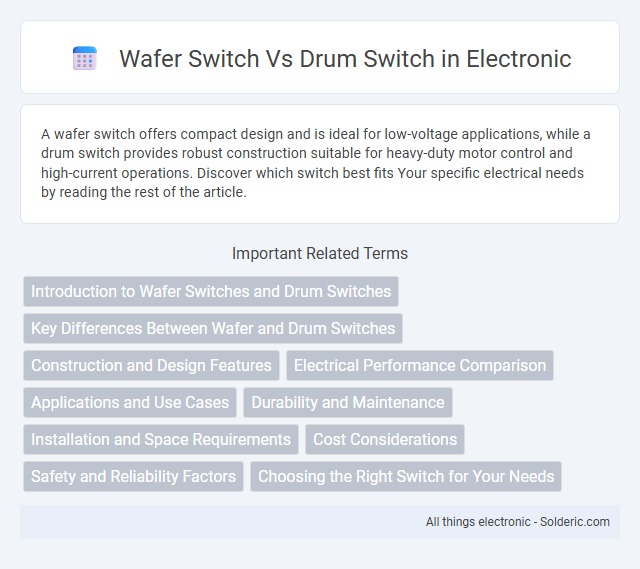A wafer switch offers compact design and is ideal for low-voltage applications, while a drum switch provides robust construction suitable for heavy-duty motor control and high-current operations. Discover which switch best fits Your specific electrical needs by reading the rest of the article.
Comparison Table
| Feature | Wafer Switch | Drum Switch |
|---|---|---|
| Definition | Compact rotary switch using thin, layered wafers for circuit control. | Rotary switch with a cylindrical drum that rotates to select circuits. |
| Construction | Multiple flat wafers stacked and insulated. | Single cylindrical drum with contact segments. |
| Application | Used in low voltage electronic devices, instrumentation. | Used in heavy duty electrical applications, motor controls. |
| Switching Capacity | Low current and voltage handling. | High current and voltage capability. |
| Size | Small, compact design. | Larger and bulkier. |
| Durability | Moderate; suited for frequent switching in electronics. | High; designed for industrial heavy-duty use. |
| Cost | Generally lower cost. | Higher cost due to robust construction. |
| Typical Uses | Audio equipment, measurement devices. | Motor reversing, multi-phase power switching. |
Introduction to Wafer Switches and Drum Switches
Wafer switches consist of multiple flat, stacked wafers with conductive paths, allowing for compact, multi-circuit control primarily in low-voltage applications. Drum switches feature a cylindrical drum mechanism controlling heavy machinery by rotating selectors to engage different circuits, ideal for industrial motor control. Your choice depends on whether you need compact multi-position control (wafer switch) or robust, high-current switching (drum switch).
Key Differences Between Wafer and Drum Switches
Wafer switches are compact, flat, and designed for low-voltage applications with a simple rotary mechanism, while drum switches are bulkier, intended for higher power control in industrial settings, utilizing a cylindrical drum to manage contacts. Wafer switches provide limited poles and throws, suitable for signal routing, whereas drum switches offer multi-position control with enhanced durability and the ability to handle heavy currents. The distinct construction of wafer switches emphasizes space savings and low cost, in contrast to the robust, heavy-duty design of drum switches optimized for complex motor control tasks.
Construction and Design Features
Wafer switches feature a compact, modular design consisting of multiple thin wafers stacked to form electrical contacts, enabling easy customization for various circuit configurations. Drum switches utilize a cylindrical drum mechanism that rotates to open or close multiple contacts simultaneously, offering robust operation for industrial motor control. Your choice depends on the required durability and application complexity, with wafer switches favoring space efficiency and drum switches providing mechanical reliability.
Electrical Performance Comparison
Wafer switches typically offer faster switching speeds and lower contact resistance, making them ideal for precision electrical applications requiring reliable signal integrity. Drum switches excel in handling higher current loads and provide robust mechanical durability, suited for industrial motor control and heavy-duty circuits. Your choice between wafer and drum switches should consider the specific electrical performance needs, including current capacity, switching speed, and operational environment.
Applications and Use Cases
Wafer switches are commonly used in household appliances, audio equipment, and instrumentation for low-current applications requiring compact and reliable switching. Drum switches are favored in industrial settings for controlling heavy machinery, motors, and hoists due to their robust design and ability to handle high current loads. Both switches are essential for precise control, with wafer switches excelling in compact electronic circuits and drum switches in heavy-duty mechanical operations.
Durability and Maintenance
Wafer switches feature simple construction with fewer moving parts, resulting in moderate durability and lower maintenance requirements suitable for light to medium-duty applications. Drum switches offer enhanced durability due to robust metal components and sealed designs, making them ideal for heavy-duty environments with higher resistance to wear and contamination. Maintenance for wafer switches typically involves occasional cleaning and contact inspection, while drum switches require more regular lubrication and mechanical adjustment to ensure longevity.
Installation and Space Requirements
Wafer switches feature a compact design, allowing for easier installation in limited or confined spaces due to their slim profile and modular assembly. Drum switches require more physical space because of their bulkier construction and rotary mechanism, making them less ideal for tight installations. The simpler mounting process of wafer switches often reduces labor time and allows for more flexible wiring configurations compared to drum switches.
Cost Considerations
Wafer switches generally cost less due to simpler construction and fewer components, making them suitable for budget-conscious applications. Drum switches, with their robust design and higher durability, often entail higher initial investment but provide greater longevity and reliability in industrial settings. Evaluating total cost of ownership, including maintenance and replacement frequency, is crucial when choosing between wafer and drum switches.
Safety and Reliability Factors
Wafer switches feature a compact design with insulated contacts that reduce the risk of accidental short circuits, enhancing safety in low-voltage applications. Drum switches provide robust mechanical interlocking and durable enclosures, offering reliable operation under heavy-duty conditions and higher voltages. Your choice should consider the operational environment and required safety standards to ensure maximum reliability and protection.
Choosing the Right Switch for Your Needs
Selecting the right switch depends on your application's complexity and switching requirements. Wafer switches offer compact design and multiple circuit control, ideal for precise, low-voltage settings, while drum switches provide robust, heavy-duty operation suitable for high-power motor control. Understanding your load specifications and control preferences ensures your switch choice maximizes efficiency and safety.
wafer switch vs drum switch Infographic

 solderic.com
solderic.com